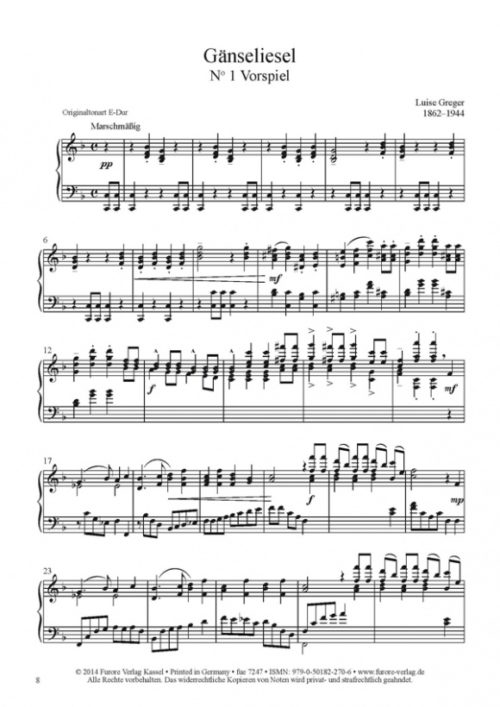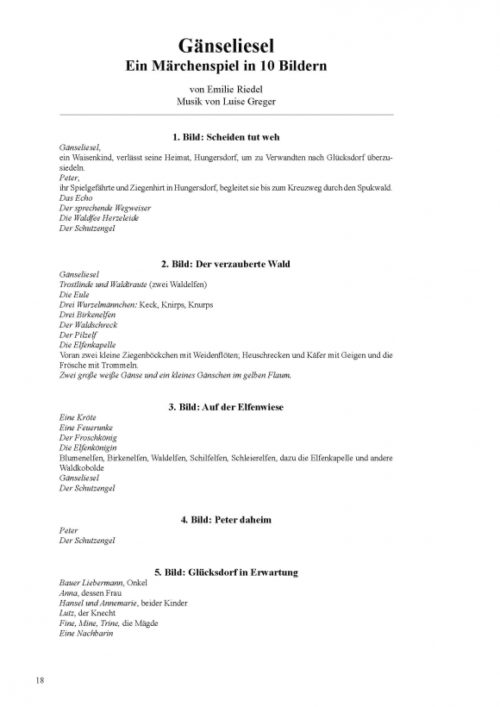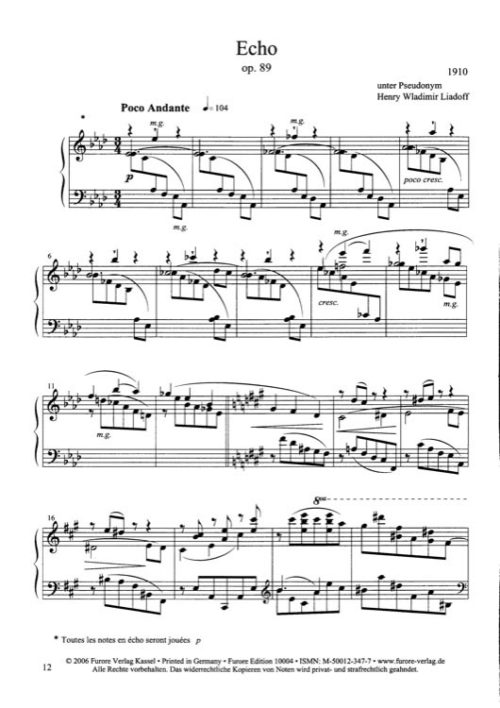Description
Gänseliesel op. 170
A fairy tale (120‘)
fue 26228
Edition: score (spiral binding)
Première: 10.12.1933, Stadttheater Baden-Baden
Hauptrollen: Liese Sopran / Peter, ihr Freund Sprechrolle / 2 Birkenelfen Sopran, Mezzosopran / Echo Sopran / Elfenkönigin Melodram / Feuerunke Bass (Alt)
Froschkönig Sprechrolle / Herzeleide (Waldfee) Mezzosopran / Keck, Knirps, Knurps / (3 Wurzelzwerge) Sopran, Alt, Alt / Kröte Mezzosopran / Musikanten chorisch / Pilzelf Mezzosopran / Schutzengel Mezzosopran / Trostlinde, Waldtraute (2 Waldelfen ) Sopran, Alt / Waldschreck Sprechrolle / Wegweiser Bass
Nebenrollen (weitere Sprechrollen) / Bauer Liebermann und Anna, seine Frau Annemarie und Hansel – ihre Kinder / Lutz – Knecht / Fine, Mine, Trine – Mägde / eine Nachbarin / Marianne – ihre Tochter / Georg, Fränzel, Karl, Line – Dorfkinder / Nikolaus / Christkind / Knecht Ruprecht / Statisten: Dorfbewohner, eine Schar Engel
Ballett
Orchester: Flöte, Oboe, Klarinette in A/B, Fagott, Horn I in F, Horn II in F, Trompete in C, Posaune, Pauken, Schlagzeug (Becken, Glockenspiel, Große Glocken, Holztrommel, Kastagnetten, Tambourin, Triangel, Kleine Trommel, Große Trommel), Harfe, Klavier, Celesta, Orgel, Streicher
The composition Gänseliesel represents the high point in Luise Greger’s career. The libretto was written by the poet Emilie Riedel, a resident of Baden-Baden. The Baden-Baden city theatre procured the piece as its Christmas fairy-tale production for the 1933/34 season.
The premiere took place in the small auditorium of the Baden-Baden Municipal Theatre on 10 December 1933. 13 performances were given, the last of which was on 4 February 1934. Else von Hagen directed the performance and musical direction was in the hands of chamber musician Eugen Oschatz, a violinist and pianist with the Baden-Baden Municipal Orchestra. Irma Fink was in charge of the choreography.
During clearing-up work at Kassel University Library, the State Library and Murhard Library of the City of Kassel at the end of September 2017, the complete set of orchestra parts from the Baden-Baden premiere was found. This find enabled a score of the fairy-tale play to be created. Up until then only a piano reduction was
extant. This only contained sparse details of the other instrumental parts. Therefore, it was only after the discovery of the premiere parts that the original instrumentation could be determined.
From a genre perspective, Gänseliesel is closely related to the type of musical stage plays that were modern towards the end of the 1920s.
The work has 10 scenes with 26 main numbers, some of which are subdivided. Instrumentation was by Hans Steinkopf. He was musical director of the state theatre in Kassel in 1930 and 1931. On the last page of the piano part, the copyist can be identified as Fritz Rudolff, a musician from Kassel.21 The source from which he copied is unknown. Along with the individual parts, the piano reduction was also used in creating the score.



















